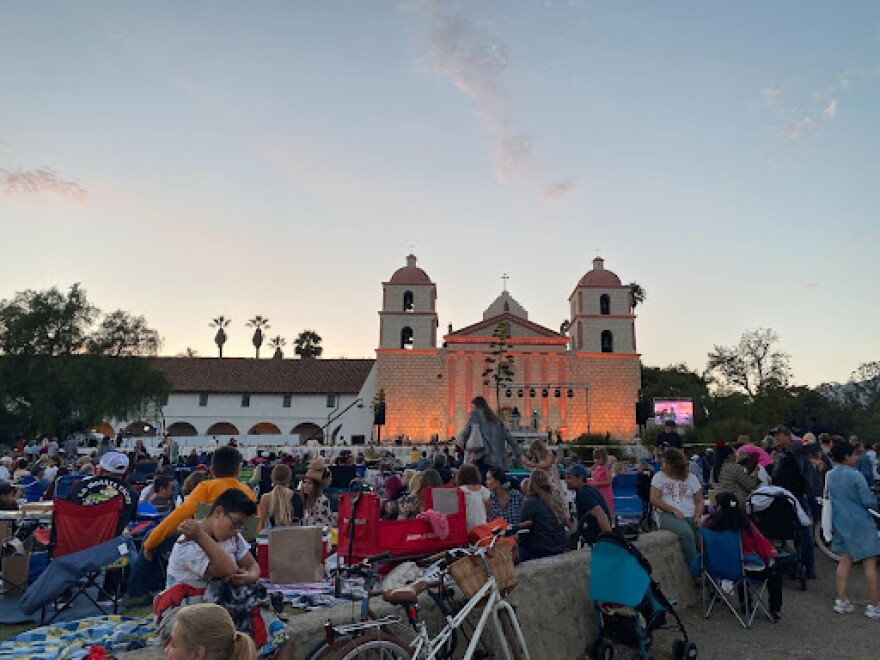The grass surrounding Santa Barbara’s Old Mission was barely visible under a sea of lawn chairs and picnic blankets earlier this month. Thousands gathered for the kickoff event of Santa Barbara’s 98th annual Old Spanish Days celebration.
Also known as Fiesta, the five-day festival celebrates the city’s early Spanish and Mexican influences. Large-scale events are hosted through the weekend, including a horse show and rodeo, an equestrian parade, an arts and crafts show, and a large children’s parade.
“It’s an honor to represent an organization that I’ve been a part of for a long time,” said Maria Cabrera, Fiesta La Presidente this year. She’s been volunteering with Old Spanish Days for the last 30 years, and has served on the board since 2006.
Cabera says some of the festivities were smaller than they had been pre-pandemic. The famous equestrian parade is one of the largest in the nation, normally bringing in around 600 horses. This year, the celebration scaled back to around 300 horses.
But even on a smaller scale, Cabrera couldn’t be happier with how the festival turned out.
“Being able to come back and have the community be part of it, and see them enjoy themselves was just really fantastic,” Cabrera said.
Local dance groups trained all year to participate in the Old Spanish Days kick-off ceremony, La Fiesta Pequeña or “Little Fiesta.” Regina Santos-Moreno is a dancer with Xochipilli de Santa Barbara, a Traditional Mexican Folkloric Dance Group.

“We came back to full practices at the beginning of the year, and we were kind of nervous to see if people would show up, if people were interested in joining. A lot of people came out and we have a lot of new dancers this year,” Santos-Moreno said.
She said it meant a lot to come back to the Old Mission stage after the pandemic hiatus.
“I've been with the group for almost ten years, so it was really exciting to get all these new people that are interested in exploring more of their culture and of Mexican culture and of getting the experience of performing in front of such a large audience,” she said.
René García Hernández, who performed alongside Santos-Moreno, points to dance as a source of cultural pride and community building.
“Dance brings people together, and that is exactly what Xochipilli is all about. Familia or like, we like to say como unidad, unity,” Hernández said. “We are here to just represent and share all the love and unity and solidarity that we bring, as we occupy Chumash land.”
Hernández isn’t the only one to point to the land the Mission stands on. Long before Spanish settlers arrived on the Central Coast, the Chumash occupied a territory of more than 7,000 square miles from what is now Malibu to Paso Robles.
But beginning in 1796, Spanish settlers colonized the area and forced the Chumash into the mission system after their society was devastated by violence and European-brought diseases.
For Spenser Jaimes, who is Šmuwič-Chumash, the celebration glorifies a time in history that was violent and traumatic for his ancestors. Jaimes’ ancestral villages are Syuxtun (now Santa Barbara) and the island of Limuw, now known as Scorpion’s Ranch on Santa Cruz Island.
Jaimes distributed an Instagram infographic this year urging folks not to participate in Old Spanish Days. The first slide of the post reads “No Pride in Genocide.”

“To have our spiritual ways of life stripped to us, like our ceremonies, our language, everything stripped from us and forced to be Catholics and to live in that way of life, which is completely different from us. It still affects us today,” Jaimes said.
It’s estimated that at least two thirds of the Chumash population were killed off by disease and violence at the hands of Spanish settlers. Thousands were enslaved in the mission system, and many were kidnapped, raped, and separated from their families.
“Growing up here, I was taught that my people were extinct and I was told by educators and academics that I'm not really Chumash because they're all dead.”
Jaimes recalls a complete absence of Chumash perspectives in his historical education. And that lack of education extends far beyond just grade school.
“The mission doesn't even acknowledge that we were in that we were slaves, the city of Santa Barbara doesn’t acknowledge that we were slaves. In the writing and the historical documents, we weren't documented as slaves. Forced labor is, is the word that they use a lot,” he said.
Fiesta’s theme this year was Todos Juntos en Familia – translated to “All Together in Family.” But Jaimes points out that there were no Chumash families represented on this year’s Fiesta poster.
“Ask where we were during that celebration. The answer is that we were probably cooking. We were probably, you know, being their servants and slaving away. Our families weren't together. Your families were together, but ours weren't,” Jaimes said.
Jaimes acknowledges that Fiesta serves as a celebration of Spanish and Mexican culture. But, he says there’s a time and place.
“Flamenco dancing is beautiful and I love it, my sister did flamenco dancing. I think you can totally celebrate Spanish and Mexican culture, just not here.”
Critiques of Old Spanish Days have surfaced over the years. But defenders of the festival say that it celebrates a time period after Spanish colonization – when the area was under Mexican and American rule, not Spanish.
That period was known as The Rancho Period, from around 1824 to 1864. It refers to the latter half of the 19th century, when Spanish was still the primary language in California before English became more common. Hence the name, Old Spanish Days.
“I do understand the issues that happened when the missions were established. But we're not necessarily talking about that period,” La Presidente Maria Cabrera said.
“The reason we are called Old Spanish Days are not because we're trying to keep this Spanish position alive, but because we are trying to remember the times when Spanish was spoken in California. And along with the language comes through the traditions of hospitality.”

But for Jaimes, celebrating the mission system across California still beckons to ongoing violence – regardless of what time period it’s meant to celebrate.
“The city hall is right where the Presidio is, nothing much has changed. It’s just a new government, the same spot. You know, still actively displacing us,” he said.
However, Jaimes is not attempting to speak on behalf of all Chumash people. For one, the Santa Ynez Band of Chumash Indians is an annual sponsor of Old Spanish Days. In a statement to KCBX News, Tribal Chairman for the Santa Ynez Band of Chumash Indians Kenneth Kahn said:
“As the largest annual community event in Santa Barbara County, Old Spanish Days brings together families from different cultures and different generations to take part in multiple days of family-friendly festivities. We have some Chumash families who participate, while others choose not to, and we respect those different perspectives within our community.”
Cabrera and Jaimes agree that more education is needed surrounding Santa Barbara’s history. But what that education looks like depends on who you ask. Chumash perspectives have long been ridden off as hearsay.
“Our stories are oral history that is passed down, from generations to generations. And that's not academically acceptable. It has to be written down, but we didn't have a written language because we just didn't need that,” Jaimes said.
“I just think we need more education on both sides,” Cabrera said. “I feel that there is the opportunity to talk and come up with some great ideas so that everyone would be much happier and participate in the festival.”
The Old Spanish Days celebration will celebrate its 100th anniversary in 2024, to coincide with the 100th anniversary of the Lobero Theatre.
More information about Old Spanish Days is avilable here. More information about Spenser Jaimes and his documentary film work is available here.




